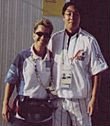Wow! What an experience! I was honored to have been chosen last year as a volunteer to work at the 2004 Summer Olympics in Athens, Greece. As part of the Athens Olympic Committee Medical and Health Services Sports Massage Team, I was assigned to the baseball venue and to the Olympic Residential Village.
The medical hierarchy in Greece followed the traditional mainstream, where athletic trainers and chiropractors are not recognized, and sports massage therapy is misunderstood and thought of as just a form of relaxation - although the athletes knew of the benefits these therapies provide. Acupuncturists are not recognized as part of the Medical and Health Services Team, either. This was no surprise.
 Dr. Wimmer and Tokuyoshi Kono, an athletic trainer and acupuncturist from Japan, pose for a photograph at the 2004 Summer Olympics in Athens.
Throughout the Olympics, I really got to know other physiotherapists, doctors and trainers who traveled internationally with the individual Olympic teams. One in particular, Tokuyoshi Kono, MS, ATC, was from Japan. I was so excited to learn he was also an acupuncturist. He even had a twinkle in his eye after I told him that I, too, was a certified athletic trainer and acupuncturist. We bonded, and shared common stories in treating athletes with acupuncture; types of needles used; different needling techniques; kinesiotaping techniques; and similar experiences associated with using traditional and non-traditional medical methodologies within sports medicine. It is very rare to meet someone with similar credentials in this arena. He mentioned that even in Japan, there are only a few dual-credentialed trainers/acupuncturists. Many Japanese students come to the United States to get their athletic training certification and then return to Japan.
Dr. Wimmer and Tokuyoshi Kono, an athletic trainer and acupuncturist from Japan, pose for a photograph at the 2004 Summer Olympics in Athens.
Throughout the Olympics, I really got to know other physiotherapists, doctors and trainers who traveled internationally with the individual Olympic teams. One in particular, Tokuyoshi Kono, MS, ATC, was from Japan. I was so excited to learn he was also an acupuncturist. He even had a twinkle in his eye after I told him that I, too, was a certified athletic trainer and acupuncturist. We bonded, and shared common stories in treating athletes with acupuncture; types of needles used; different needling techniques; kinesiotaping techniques; and similar experiences associated with using traditional and non-traditional medical methodologies within sports medicine. It is very rare to meet someone with similar credentials in this arena. He mentioned that even in Japan, there are only a few dual-credentialed trainers/acupuncturists. Many Japanese students come to the United States to get their athletic training certification and then return to Japan.
What an honor it was to be able to participate. For me, it was the highlight of my professional career as a sports massage therapist, certified athletic trainer and acupuncturist.
Another profound element I gathered from the Olympics is that I was able to talk with the other medical professionals and educate them about sports massage, athletic training and acupuncture. In one instance, one of the delegates, an American nurse, had a severe headache. The doctor was ready to give her some medication; I asked if I could try something. I proceeded to stimulate LI 4 using my fingers (acupressure) very strongly. Within minutes, her headache went away. She was shocked. I checked with her a few hours later to see how she was doing. She could not believe her headache was gone.
This example opened a line of communication to educate her and the observing doctors about acupuncture and the efficacy of Oriental medicine. I made many new friends, not only with the medical team, but also with coaches, athletes, delegates, other volunteers and many fans.
Sports massage was, by far, the busiest and one of the most popular medical specialties among the athletes at the Olympic Village. Sports massage has been progressing forward slowly. This year was a milestone, as it was the first time sports massage was recognized and included within the Olympics as part of the Medical and Health Services Team. It has been a long and convoluted road to get to this point, one very similar to the path of Oriental medicine. (Much gratitude goes to the Athens Health Services Sports Massage Team 2004 co-directors for their dedication and perseverance in making this happen. Most people do not realize the time, effort and problem-solving involved in making this happen.) In time, just as with chiropractic and sports massage, acupuncture and Oriental medicine will be part of the medical team. The key is education.
My experience in Greece involved more than just working on the athletes. It was about educating and treating from a multispecialty perspective. It was also about integrity, respect, determination and discipline, not just athletically, but professionally and personally. Oriental medicine has a great deal to offer using traditional Chinese diagnostic methodologies, as do sports massage, physiotherapy, athletic training, chiropractic, nursing, medicine and other medical specialties. The key is integration and collaboration. The diagnostic methodologies in both Western and Eastern philosophies have merits in their own rights. There are some similarities between the two; there are also distinct differences. Each has its own diagnostic order of progression, with very different diagnosis and treatment strategies. All of these diagnostic and treatment strategies are even more beneficial when used synergistically.
To elicit better interdepartmental communication, each discipline must respect the expertise of the others. One must educate oneself about multiple disciplines to provide a better basis to draw more accurate conclusions in any given situation. This allows for better dialogue among multiple medical professions, as was experienced in Greece. I was able to explain a myriad of analogies to impart better comprehension of acupuncture/medicinal herbs, sports massage, athletic training, and chiropractic to medical doctors that did not understand their basis on a global scale. This truly was the experience of a lifetime.
Click here for previous articles by Ronda Wimmer, PhD, MS, LAc, ATC, CSCS, CSMS, SPS.




